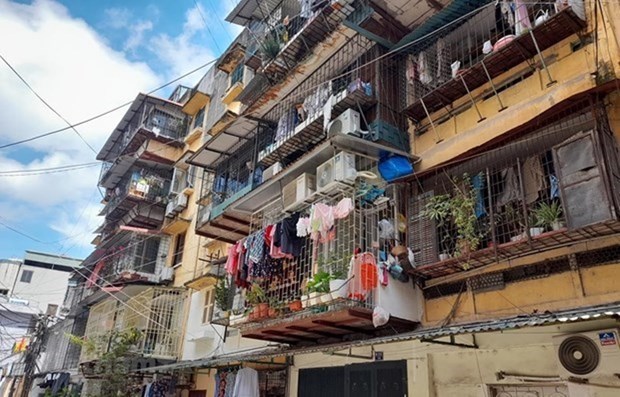Hanoi needs to install earthquake monitoring systems: Experts
Experts have recommending installing an earthquake monitoring system in Hanoi as the capital city’s old apartment buildings are at risk if disaster strikes.

Experts have recommending installing an earthquake monitoring system in Hanoi as the capital city’s old apartment buildings are at risk if disaster strikes.
Hanoi has nearly 1,600 old apartment buildings, many of which have fallen into disrepair.
According to Construction Work Management Department under the Ministry of Construction if an earthquake measuring 4-5 on the Richter scale occurs, old apartment building could face extensive damage.
Newly-built blocks can resist quakes measuring eight on the Richter scale.
Associate Professor Cao Dinh Trieu, vice president of Vietnam Association of Geophysicists and director of Institute for Applied Geophysics, said Hanoi is located in the Red River-Chay River fault zone where earthquakes with a magnitude of 5.1-5.5-magnitude have happened.
The recurrence period for an earthquake measuring magnitude 5.3 in Hanoi is 1,100 years, and the last strong earthquake occurred more than 700 years ago in 1285.
“If an earthquake occurs in the city, it will cause big tremors," he said.
"If an earthquake with a magnitude of four or more happens, old apartment buildings will be at serious risk."
Because of poor ground, Hanoi might feel vibrations from other major earthquakes in other countries. Recently the local residents reported vibration affected by earthquakes from neighbouring countries like Laos and China.
At about 8.45pm on December 24, 2021, many people living in high-rise buildings in Hanoi felt strong shaking which was determined to be the impact of a 5.5 magnitude earthquake in Laos.
In recent years, many localities in Vietnam reported a series of stimulating earthquakes. A strong earthquake with magnitude 6.9 happened in 1935 in Dien Bien Basin (1935).
Trieu said the impact of aftershocks of large earthquakes occurring in another country also causes potential risks.
He said the Institute of Geophysics had in the past proposed building a system of nine earthquake monitoring stations in Hanoi. However, after a period of operation, the system was suspended due to a shortage of funds for general maintenance.
Trieu said big cities or large industrial zones in developed countries like China all have monitoring systems which carefully check earthquakes and can even monitor the level of terrain deformation at large construction areas.
Many other countries have building regulations that take into account possible earthquakes and insist monitoring stations should be in place.
Vietnam does not have this kind of law now so the installation of earthquake monitoring stations at construction sites is limited, except for those at hydroelectric projects or dams.
He emphasised the need to focus on seismic resistance of construction works, not only in Hanoi but also Vietnam, especially high-rise buildings to ensure safety and minimise potential risks that may occur.
He added: “I think we need to pay attention to strengthening and re-establishing the network of earthquake monitoring stations in Hanoi.
"This is important because recently every earthquake that has happened has caused many buildings to shake, possibly because the foundations of buildings in Hanoi can be a bit weak.”
Nguyen Xuan Anh, president of Institute of Geophysics, said installing earthquake monitoring stations is an important solution to record data as well as to analyse and evaluate the intensity of earthquakes in order to make specific recommendations for each area.
Citing specific examples in Kon Tum and Quang Nam provinces with frequent stimulant earthquakes in the past five years, he said in early 2023, hydropower investors coordinated with the Institute of Geophysics to install eight earthquake monitoring stations in these localities.
Those stations have provided quick earthquake reports, collected detailed data and assessed danger levels. On that basis, the stakeholders are responsible for training earthquake response skills to managers and residents in the possibly-affected area and neighbouring regions, he said.

